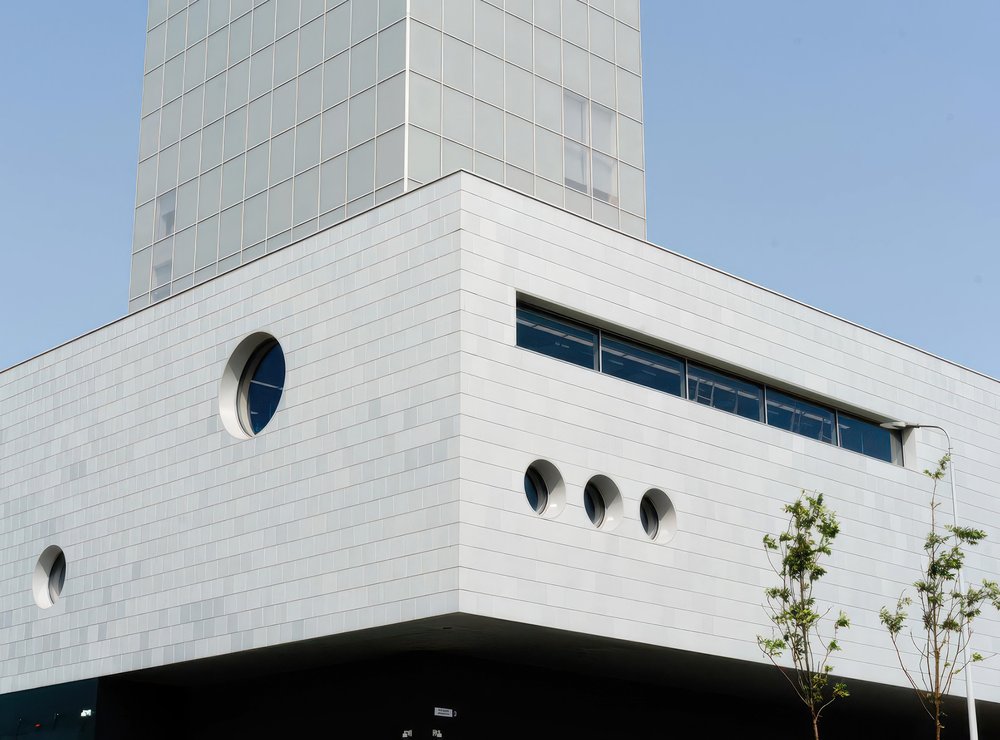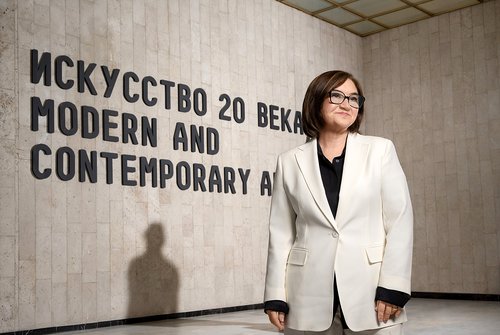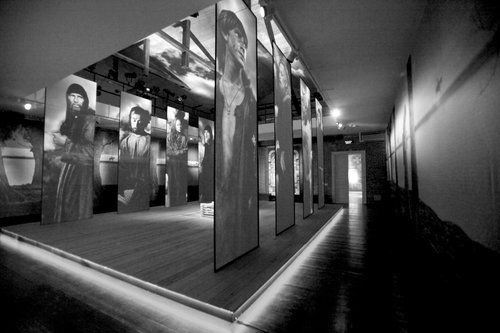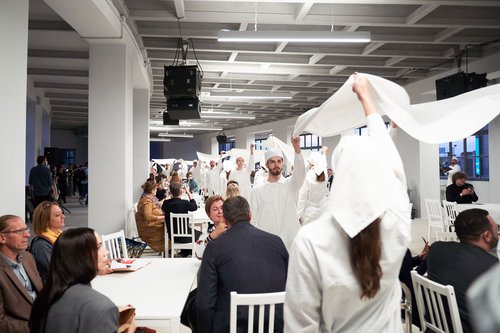State Tretyakov Gallery Opens a Branch in Kaliningrad

The building of the State Tretyakov Gallery Branch in Kaliningrad. Courtesy of the State Tretyakov Gallery
Russia’s leading museum of national art has opened a new branch on the country’s western border. The ultramodern new building features vast public spaces, a gilded staircase, and a space for children with contemporary art.
A museum, at least a great one, is a living organism that can grow and multiply, like all living things. The Guggenheim is the textbook case of cultural expansion, with three branches in New York, Bilbao, and Venice, as well as three now-defunct ones in Berlin, Las Vegas, and Guadalajara. Another success story is the Louvre’s franchise in Abu Dhabi. Russia’s largest art institutions also have ambitions to grow. The Hermitage was one of the first to expand, opening ‘satellite centers’ in Kazan, Vyborg, Omsk, Ekaterinburg, and Orenburg. The Hermitage even launched two overseas branches, one in Las Vegas in partnership with the Guggenheim and one in Amsterdam. Neither of them lasted long. The State Russian Museum in St. Petersburg still has a branch in Málaga, although it has not sent any new exhibitions there during the past three years.
The State Tretyakov Gallery, Russia’s main museum of national art, has the most ambitious expansion plans, to literally spread its wings from the west to the east across eleven time zones. In 2024 its first branch opened in Samara, a city in central Russia. It occupies a hammer-and-sickle shaped Constructivist building that was once a kitchen factory where lunches were mass-produced for workers from a nearby plant. The second branch has just opened in Kaliningrad, the birthplace of Kant and originally known as Königsberg in Eastern Prussia. After Germany’s defeat in World War II, the city and its surrounding area were taken over by the USSR and are now Russia’s outpost in Central Europe, sandwiched between Poland and Lithuania. Finally, a third branch in Vladivostok in the Far East, is expected to open in 2027.
Unlike its sister institution in Samara, the Kaliningrad branch has been built from scratch. To any Muscovite, the source of inspiration seems obvious: the Central House of Artists in Moscow. This rather bland, late modernist building houses the Tretyskov Gallery’s 20th and 21st century art collections, as well as temporary exhibition spaces. The main difference is that the sprawling, square-shaped Kaliningrad structure has a tall glass tower in the middle that houses technical equipment and staff offices (perhaps a nod to the gilded tower designed by Rem Koolhaas for the Prada Foundation in Milan.) Designed by the Moscow-based architectural firm Meganom, the building is part of a forthcoming "cultural-educational complex," a cluster of spectacular new buildings on a flat, windy island in the middle of the city. The complex will also house a branch of the Bolshoi Theatre, a sports arena, and schools for drama, music, and dance, all of which are currently under construction. The interior of the new museum is designed with future students in mind, offering a wealth of public spaces where people can relax and escape the capricious Baltic weather. Only 4,500 of the total 17,500 square meters of the museum’s floor space are dedicated to art and anyone can visit the entire ground floor of the vast, square-shaped structure for free. Once complete, this space will accommodate two museum shops, a café, a restaurant, a reading area, and a 20-metre-wide staircase with steps that double as seating to be used also for film screenings and performances. As much of the ground floor is currently closed the huge space feels desolate. The choice of materials is surprising, to say the least. There are three different colours of ceramic tiles on the walls, and in another possible nod to Koolhaas, the cylinder hiding the small spiral staircase leading to the second floor is covered with gold leaf.
However, once up on the first floor, the space suddenly feels crowded. The inaugural exhibition called 'Five Centuries of Russian Art', has proved to be exceptionally popular, with tickets and tours selling out days in advance. It features a curated selection of some three hundred works of art from the Tretyakov collection, ranging from icons to Soviet non-conformist pieces. Well-known artists belonging to the most important styles and movements in Russian art are all represented here by one or two pieces. Highlights include the ‘Black Square’ (1929) by Kazimir Malevich (1879–1935), a later version of his seminal 1915 painting. The artist created four versions of this iconic piece, two of which are now in the gallery’s collection. A few interesting works by lesser-known artists provide necessary context. These include rare gems such as portraits of the poets Anna Akhmatova (1914) and Nikolai Gumilev (1909), painted by Olga Della-Vos-Kardovskaya (1875–1952). The exhibition concludes with a 2007 painting by Erik Bulatov (b. 1933), 'Clouds are Growing', which serves as a bridge into the 21st century. Each exhibition will last from between six and eight months. The next one, scheduled to open in early 2026, will focus on the early 20th century and the avant-garde. On the same floor, there is a small but informative display about the history of the Tretyakov Gallery itself, as well as creative workshops where visitors can experiment with various artistic mediums and a dedicated space for children.
The attitude of this new branch towards contemporary art seems ambiguous. On the one hand, it has a permanent exhibition of works by mid-career contemporary Russian artists, most of whom are in their forties and play an active role in the nation’s art scene. This is something that the main Moscow branch of the Tretyakov currently lacks after its New Trends department was disbanded in 2024. However, this display is located in an unlikely place: the children space. Children are introduced to the fundamentals of various art forms, composition, colour theory, and the peculiarities of our perception of art through interactive displays and intriguing artworks by Evgenia Buravleva (b. 1980), Egor Plotnikov (b. 1980), Daria Konovalova-Infante (b. 1978), Leonid Tishkov (b. 1953), Roman Ermakov (b. 1985), among others. Some pieces have been commissioned especially for the exhibition, including a mural by Misha Most (b. 1981), who started out as a street artist. Rostan Tavasiev (b. 1976) has created three works using his signature begotomopis (hippo-painting) technique (painting with stuffed toys), which he abandoned many years ago.
The Blue Soup group's pseudo-documentary video of a mysterious break in the sea (Untitled, 2009) establishes a connection with the region's landscape. Platon Infante's (b. 1977) mixed-media piece has already been damaged by children – apparently, the young visitors did not realise that the eye-catching screen with pieces of wood glued to its surface was not interactive. The exhibition, titled 'A Sea of Possibilities', is intended to last for five years. Assuming they survive daily encounters with young visitors, the future of the artworks remains unclear. Officially, most of the works have been lent by the artists. Despite the exhibition's shortcomings, where the main focus seems to be on entertainment and interactivity and the artworks are reduced to visual aids in the background, the idea of giving children exposure to contemporary art is appealing. However, the question of why childfree adults are not exposed to it remains unanswered.
Five Centuries of Russian Art
State Tretyakov Gallery – Kaliningrad
Kaliningrad, Russia
12 June 2025 – 18 January 2026 (closing date subject to change)


















